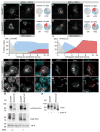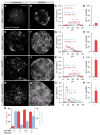Hedgehog-stimulated chemotaxis is mediated by smoothened located outside the primary cilium
- PMID: 22912493
- PMCID: PMC4557959
- DOI: 10.1126/scisignal.2002798
Hedgehog-stimulated chemotaxis is mediated by smoothened located outside the primary cilium
Abstract
Regulation of the Hedgehog (Hh) pathway relies on an interaction of two receptors. In the absence of Hh, Patched1 (Ptch1) inhibits the pathway. Binding of the ligand Hh to Ptch1 stimulates the localization of the activating receptor Smoothened (Smo) to the primary cilium, which is required for the transcriptional Hh response. Hh can also induce chemotaxis through a nontranscriptional pathway. We assessed the effects of defective ciliary localization of Smo on its subcellular trafficking and ability to mediate chemotactic signaling. Cells expressing mutants of Smo that could not localize to the primary cilium or cells lacking the primary cilium showed altered intracellular trafficking of Smo and, in response to Hh or Smo agonists, decreased transcriptional signaling and enhanced chemotactic responsiveness. Thus, the ciliary localization machinery appears to transport Smo to subcellular sites where it can mediate transcriptional signaling and away from locations where it can mediate chemotactic signaling. The subcellular localization of Smo is thus a crucial determinant of its signaling characteristics and implies the existence of a pool of Smo dedicated to chemotaxis.
Conflict of interest statement
Figures




Similar articles
-
Smoothened adopts multiple active and inactive conformations capable of trafficking to the primary cilium.PLoS One. 2009;4(4):e5182. doi: 10.1371/journal.pone.0005182. Epub 2009 Apr 13. PLoS One. 2009. PMID: 19365551 Free PMC article.
-
Single-molecule imaging of Hedgehog pathway protein Smoothened in primary cilia reveals binding events regulated by Patched1.Proc Natl Acad Sci U S A. 2015 Jul 7;112(27):8320-5. doi: 10.1073/pnas.1510094112. Epub 2015 Jun 22. Proc Natl Acad Sci U S A. 2015. PMID: 26100903 Free PMC article.
-
Pitchfork and Gprasp2 Target Smoothened to the Primary Cilium for Hedgehog Pathway Activation.PLoS One. 2016 Feb 22;11(2):e0149477. doi: 10.1371/journal.pone.0149477. eCollection 2016. PLoS One. 2016. PMID: 26901434 Free PMC article.
-
Mechanisms of Smoothened Regulation in Hedgehog Signaling.Cells. 2021 Aug 20;10(8):2138. doi: 10.3390/cells10082138. Cells. 2021. PMID: 34440907 Free PMC article. Review.
-
Sonic Hedgehog activates the GTPases Rac1 and RhoA in a Gli-independent manner through coupling of smoothened to Gi proteins.Sci Signal. 2011 Nov 22;4(200):pt7. doi: 10.1126/scisignal.2002396. Sci Signal. 2011. PMID: 22114142 Free PMC article. Review.
Cited by
-
Cellular signalling by primary cilia in development, organ function and disease.Nat Rev Nephrol. 2019 Apr;15(4):199-219. doi: 10.1038/s41581-019-0116-9. Nat Rev Nephrol. 2019. PMID: 30733609 Free PMC article. Review.
-
From mesenchymal niches to engineered in vitro model systems: Exploring and exploiting biomechanical regulation of vertebrate hedgehog signalling.Mater Today Bio. 2022 Nov 22;17:100502. doi: 10.1016/j.mtbio.2022.100502. eCollection 2022 Dec 15. Mater Today Bio. 2022. PMID: 36457847 Free PMC article.
-
Establishing Hedgehog Gradients during Neural Development.Cells. 2023 Jan 5;12(2):225. doi: 10.3390/cells12020225. Cells. 2023. PMID: 36672161 Free PMC article. Review.
-
New frontiers: discovering cilia-independent functions of cilia proteins.EMBO Rep. 2015 Oct;16(10):1275-87. doi: 10.15252/embr.201540632. Epub 2015 Sep 9. EMBO Rep. 2015. PMID: 26358956 Free PMC article. Review.
-
Epithelial stratification and placode invagination are separable functions in early morphogenesis of the molar tooth.Development. 2016 Feb 15;143(4):670-81. doi: 10.1242/dev.130187. Epub 2016 Jan 11. Development. 2016. PMID: 26755699 Free PMC article.
References
-
- Ingham PW, McMahon AP. Hedgehog signaling in animal development: paradigms and principles. Genes Dev. 2001;15:3059–3087. - PubMed
-
- Corbit KC, Aanstad P, Singla V, Norman AR, Stainier DY, Reiter JF. Vertebrate Smoothened functions at the primary cilium. Nature. 2005;437:1018–1021. - PubMed
-
- Rohatgi R, Milenkovic L, Scott MP. Patched1 regulates hedgehog signaling at the primary cilium. Science. 2007;317:372–376. - PubMed
Publication types
MeSH terms
Substances
Grants and funding
LinkOut - more resources
Full Text Sources
Molecular Biology Databases
Miscellaneous

